Pear Fruit Leather with Adaptogens
Using herbal adaptogens is an easy way to incorporate more herbs into your daily healthy living habits. Adaptogens increase stamina, reduce anxiety, boost the immune system, and modulate the fight or flight response to daily stress.
What Are Adaptogens and How to Use Them
Adaptogens are herbs that are nourishing and help the body adapt to stress.
- They are non-toxic and safe for long-term, daily use.
- They help normalize different body systems despite previous challenges or stressors.
- They can be a daily part of your healthy lifestyle
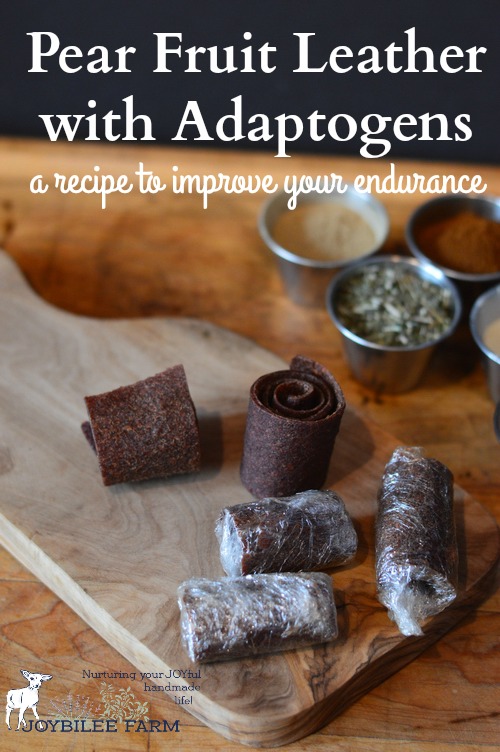
There are many different herbs that are considered mild to moderate adaptogens. Most adaptogens have other herbal actions as well as their adaptogenic benefit. (This post contains affiliate links.)
Agatha Noveille, from The Indie Herbalist blog, recently published Adaptogens, 75+ Herbal Recipes and Elixirs to Improve Your Skin, Mood, Energy, Focus, and More (Adams Media: Avon, Massachusetts) 2016. She kindly offered me a review copy of her new book so that I could share it with you.
I’ve had an interest in adaptogens for a long time. Using herbal adaptogens is an easy way to incorporate more herbs into your daily healthy living habits. Adaptogens increase stamina, reduce anxiety, boost the immune system, and modulate the fight or flight response to daily stress. I appreciate the benefits that herbal adaptogens contribute to keeping our bodies functioning efficiently.

Some herbal adaptogens that are covered in detail in Agatha’s book:
- Albizia
- Ashwagandha
- Astragalus
- Burdock
- Cordyceps
- Dang Shen
- Eleuthero
- American Ginseng
- Asian Ginseng
- Gogi berries
- Gotu Kola
- Hawthorn
- Holy Basil or Tulsi
- Fo-ti
- Jiaogulan
- Licorice
- Maca
- Nettle
- Reishi
- Rhodiola
- Schisandra berry
- Shatavari
- Suma
Zone 3 hardy adaptogens
Of these burdock, eleuthero, ginseng, hawthorn, and nettle are hardy in zone 3. Ginseng and eleuthero are understory forest herbs and take several years to grow large enough to harvest. If you have a permaculture forest garden, you can plant them in the understory. You’ll be able to harvest large roots about 5 years from planting.
Hawthorn is a tree that takes several years to bear fruit when started from seed. However, leaves, bark, flowers, and fruit can all be used for herbal remedies, so you need not wait for mature fruit-bearing before you harvest this plant for herbal medicine.
Burdock and nettle are prolific weeds and can be found in most moist garden soils. Harvest burdock root at the end of the first year, before it flowers and sets seed. Nettle is harvested when it is young and tender.
The other herbs on this list can be found at online herb suppliers like Starwest Botanicals, Mountain Rose Herbs, and The Bulk Herb Store. Amazon also carries a limited supply of reliable organic herbs to help you make the recipes in this book.
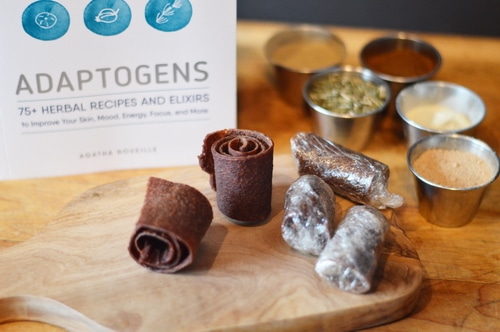
What this book does well
The real benefit of this book is the flexible recipes that are offered that can help you add more adaptogens into your diet. Agatha doesn’t just offer you tinctures and teas, the standard herbal remedies. In this book, you’ll find recipes for cinnamon candied walnuts with eleuthero, sunflower seed butter, raspberry and rhodiola yogurt, matcha and peach chia seed pudding with jiaogulan, chilli lime pistachios with dang shen, burdock skillet sauté, immune berry astragalus gummies, and many other interesting ways to add more herbal goodness to your life.
The recipes really shine. Other herbal adaptogen books, like Adaptogens: Herbs for Strength, Stamina, and Stress Relief by David Winston and Steven Maimes (2007) focus on the technical information about herbal adaptogens with information about dosage and standard herbal preparations. There is little in the way of suggestions for incorporating these beneficial herbs into a daily healthy living practice.
Adaptogens, 75+ Herbal Recipes and Elixirs offer practical ways to consume these beneficial herbs, in ways that won’t disrupt your already busy lifestyle. You won’t need to wait weeks for an adaptogen tincture to be ready to use, Agatha offers ways to utilize the herbs today. Some are as easy as adding two or three adaptogens in powdered form to recipes you already love, like adding maca to a fruit smoothie or adding astragalus and mushrooms to miso soup. Once you start using the recipes in this book, you’ll find it easy to adapt many of the recipes you already make regularly to include more adaptogens.
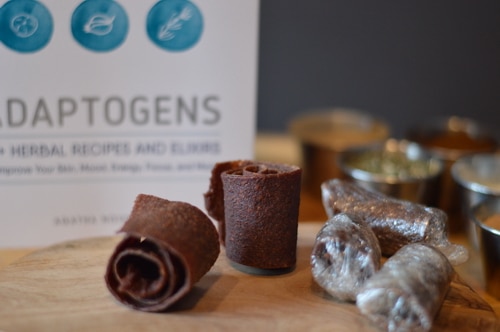
Where the book lacks substance
There are no photos, not even black and white photos. It’s hard to imagine what a recipe is supposed to look like if you’ve never seen anything like it. There are no serving suggestions. The recipe is there but you’ll need to have some experience serving herbal concoctions to know how best to present them to family members who may be new to herbs, in an attractive way.
This is best for someone with some experience using herbs in their cooking and already utilizing herbal remedies. There are brief descriptions of the main adaptogens used in the book in a glossary section, but you’ll want more detail about each herb before you try to use it with other members of the family. Agatha stresses that these recipes are for adults only and not for pregnant or breastfeeding mothers. That’s not to say, you can’t serve some of these herbs to your whole family, but you’ll want to do more research than this book offers.
This is a small trade paperback size book. The cover is smart but it may not stand out on the shelf next to other more colourful herbal books, leading you to overlook it. That would be a shame. I think you’ll find a lot of helpful information and practical recipes that you can start to use right now. This is a good companion book to the herbal reference books you already have in your personal library.
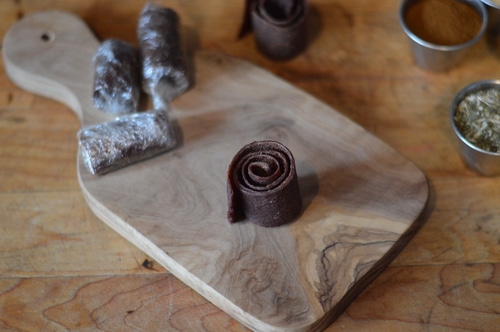
Easily get the benefit of herbal adaptogens
Consider how easy it would be to adapt some of your own favourite recipes to incorporate more herbal ingredients. You can add herbal adaptogens as extracts, tinctures, or powders to sauces, soups, desserts, and beverages. There are many examples in the recipes in this book.
Yesterday my husband’s brother passed away. It was expected. We visited a couple of weeks ago and said goodbye, as hard as that was. Every day we’ve been jumping each time the phone rang, wondering if it was his wife with the news of his passing. We called daily to offer support. Then yesterday, about an hour after we’d talked on the phone, she called. It was hard. It was stressful. It was the end of a long fight. Adaptogens can help when life’s sorrows overwhelm. They have a protective and supportive role.
Today I made pear fruit leather, inspired by one of the recipes in Agatha’s book. I had about a dozen bosc pears left in the box that was getting too soft for fresh eating. I had another box of golden delicious apples that were at their peak of sweetness. Pears alone don’t have enough pectin to give a flexible texture to fruit leather. But the pectin in the apples mediates the texture of the pears so that the fruit leather is pliable and chewy.
By adding adaptogens to your favourite fruit leather recipe you can make this finger food snack serve you better – helping you cope better with stress, boosting your immune system, and calming jangled nerves.
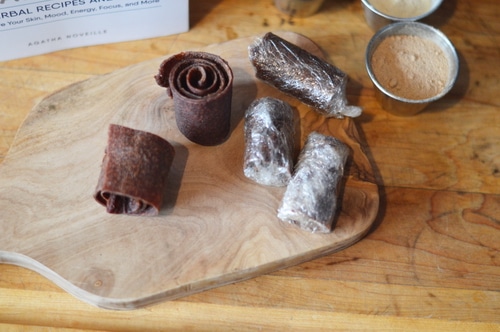
Pear Fruit Leather with Maca
Yield 8 cups or 3 large sheets of fruit leather
Ingredients:
12 medium pears
6 large Apples
½ cup Maple syrup
2 tbsp. maca root, gelatinized powder
1 tbsp. astragalus powder
1 tbsp. hawthorn powder
1 tsp. vanilla extract
Method:
Wash the fruit and remove the stem and blossom end. There is no need to peel the fruit. Cut into quarters. Simmer the pears and apples in a 3-quart pot, over medium heat, until the fruit is soft when pressed with the back of a spoon. Feedthrough a food mill to remove the seeds. Reserve the sauce and discard the seeds.
Mix the resulting sauce with maple syrup, maca root powder, astragalus powder, hawthorn berry powder, and vanilla extract. Mix until smooth and all the powdered herbs are fully mixed into the fruit sauce. There should be no lumps of unmixed, powdered herbs.
Prepare 3 large dehydrator trays by lining them with plastic wrap. If you have special fruit leather sheets you can use them instead of plastic wrap. Spread the fruit sauce mixture over the prepared dehydrator sheets in a thin, even layer about ¼ inch thick.
Dry in the dehydrator until the fruit leather is fully dry, and pliable. About halfway through the drying time rotate the dehydrator trays so that the fruit leather dries evenly. The time needed to fully dry the fruit leather will vary according to the model and manufacture of your dehydrator.
When the fruit leather is done, there should be no moist areas. When you press the fruit leather between thumb and forefinger, the fruit should be firm, without any slip.
When the fruit leather is dry but pliable, cut each sheet of fruit leather in half. Cut each half into 4 pieces of fruit leather. You’ll get 8 pieces of fruit leather from each tray. Roll up each piece of fruit leather into a tight roll, wrap individually in parchment paper or plastic wrap. Place in a wide-mouth mason jar. Cap tightly to store. Fruit leather lasts up to a year in a covered jar in a cool, dry spot. But you will want to eat it sooner than that.
Yield: 24 pieces of fruit leather.
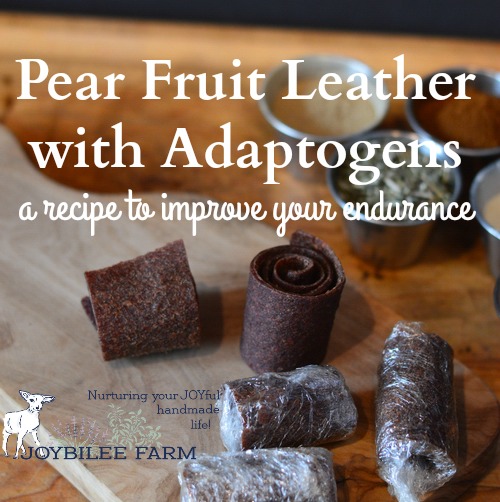
More adaptogen recipes
Green Rooibos Tea

Buy Adaptogens, 75+ Herbal Recipes and Elixirs to Improve Your Skin, Mood, Energy, Focus, and More


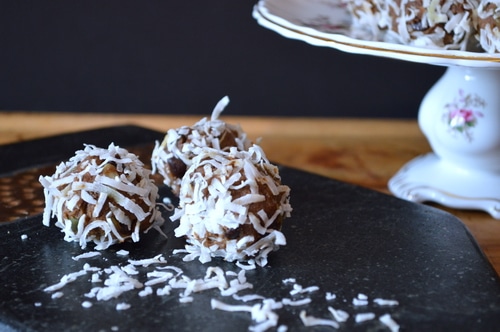


Leave a Reply